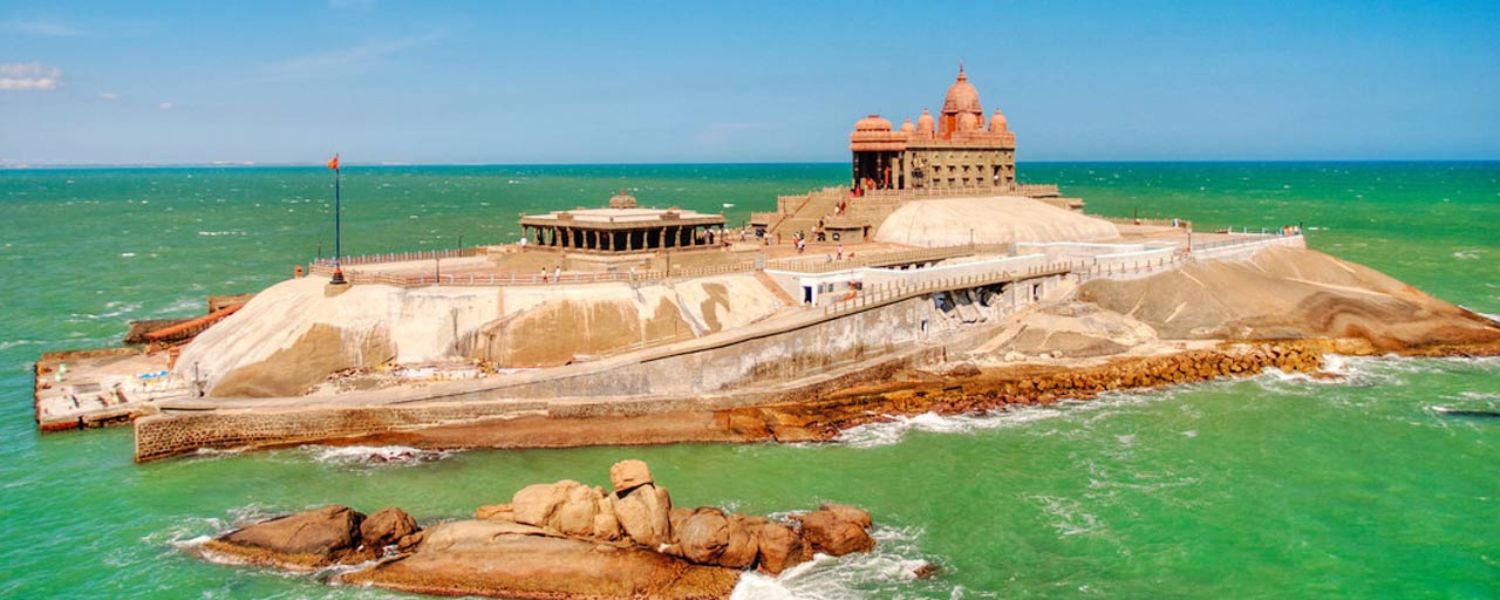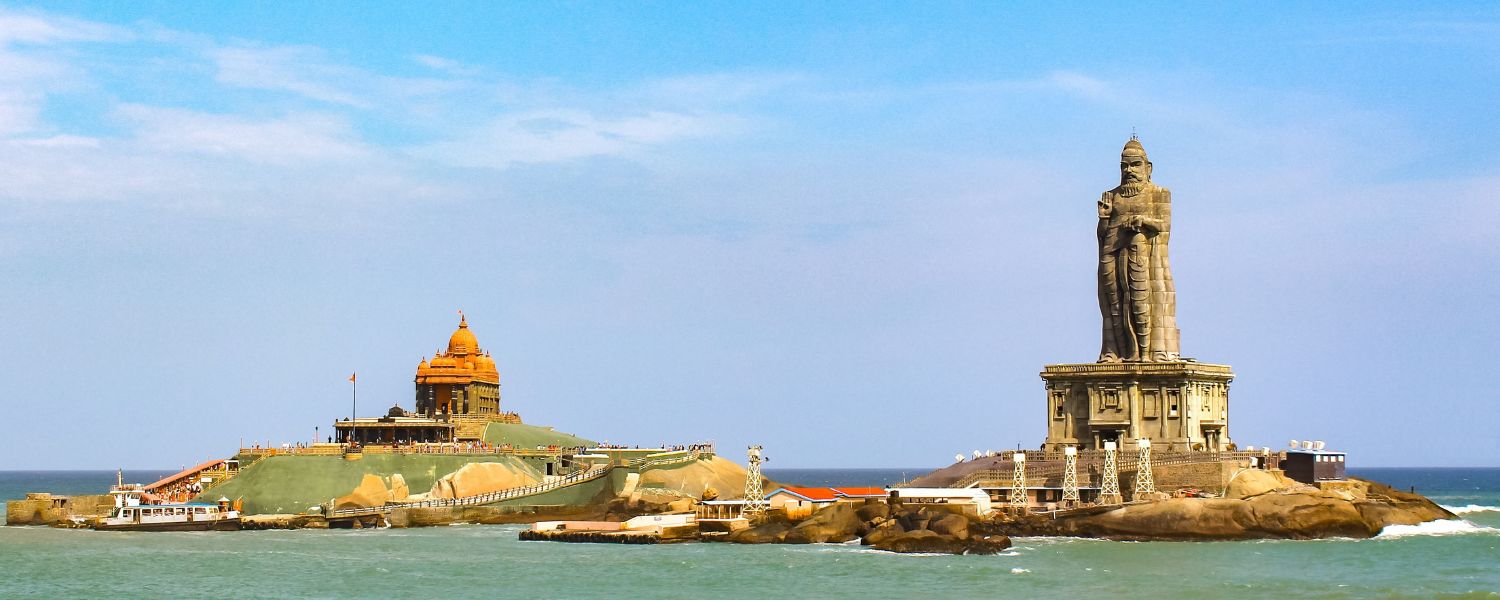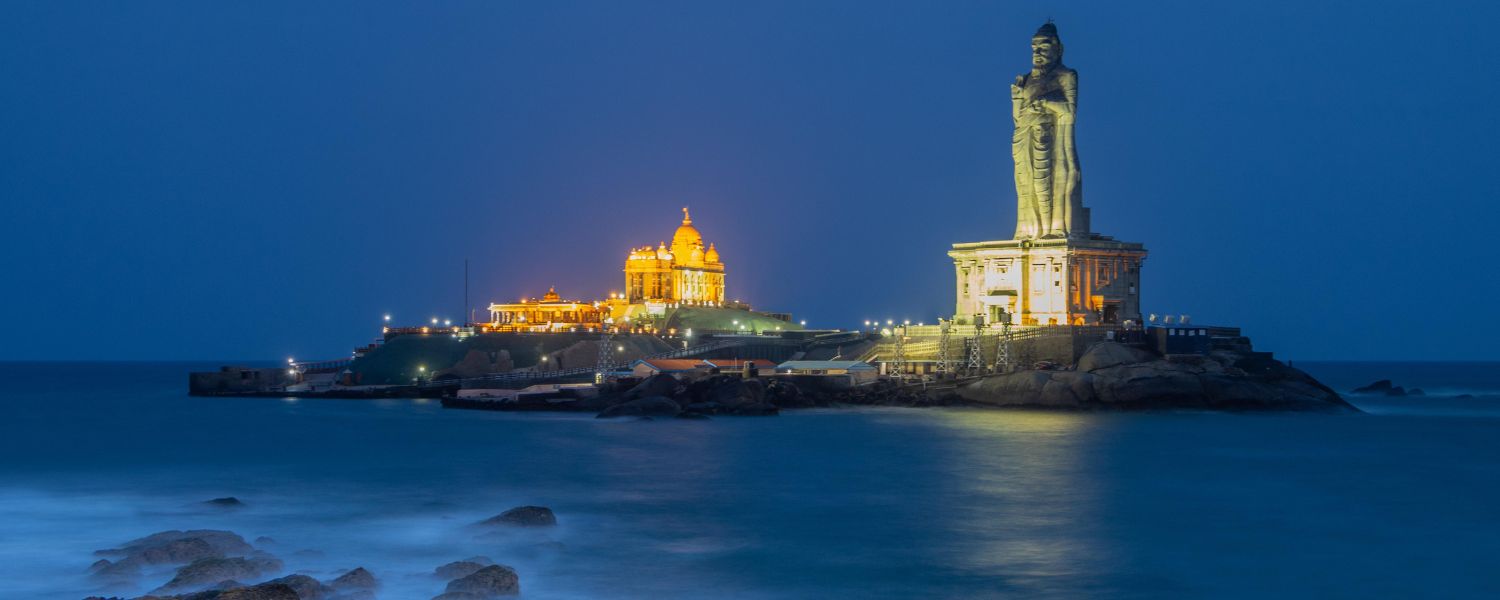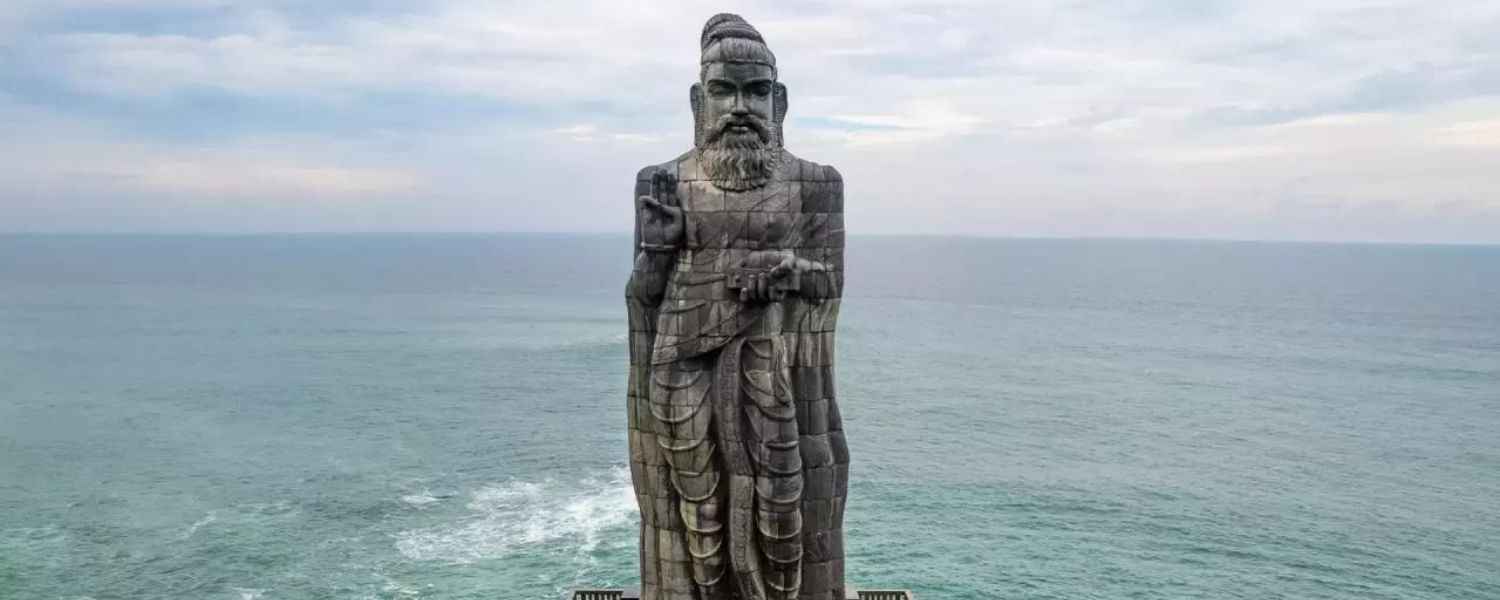Welcome to the ethereal realm of the Vivekananda Rock Memorial, the crystalline waters of Kanyakumari, India’s southernmost tip.
However, erected in 1970, this magnificent monument is a tribute to the timeless wisdom and spiritual legacy of Swami Vivekananda, whose profound teachings continue to inspire millions worldwide.
Perched on a solitary rock formation, this architectural marvel beckons pilgrims and seekers alike to embark on a transformative journey of introspection/enlightenment.
Further, with its serene ‘Shripada Mandapam’ and contemplative ‘Vivekananda Mandapam,’ the memorial offers a quiet refuge for those seeking solace and spiritual nourishment. Accessible via tranquil ferries, the Vivekananda Rock Memorial invites you to bask in its sacred aura and bask in the tranquility of its hallowed grounds.
1. History

History tells us that Kanyakumari believed in embodying Goddess Parvati and attracted women seeking blessings for marital bliss. Why Vivekananda Rock Memorial, erected by the Vivekananda Memorial Committee, commemorates Swamy Vivekananda’s transformative sojourn to “Shripada Parai” in December 1892.
Furthermore, transitioning from its spiritual roots, Kanyakumari beckons travelers with stunning vistas of sunrise and sunset, unrivaled across the nation.
However, with its tranquil allure, adventure-seekers are drawn to delve into the city’s rich cultural tapestry. Moreover, with historical landmarks and ornate temples awaiting exploration, Kanyakumari, including the iconic Vivekananda Memorial, offers an immersive journey through time and spirituality.
2. When and How to Get There

So, for travelers seeking an unforgettable experience, the Vivekananda Rock Memorial is a must-visit place in Kanyakumari. Positioned just 500 meters off the mainland, accessing this spiritual landmark is a breeze.
Additionally, transitioning into tranquility and introspection, visitors embark on a 15-minute ferry journey from Kanyakumari, available from 8 a.m. to 4:30 p.m. or 7 a.m. to 5:30 p.m. according to seasonal shifts.
Moreover, the optimal time to explore this iconic site is during the cooler months, from October to February, when the weather is delightful.
While standard tickets are Vivekananda Rock Memorial ticket price at Rs 35, for those eager to bypass queues and delve straight into the experience, a premium ticket option is available at Rs 169. Dive into the essence of spirituality and adventure, and let Vivekananda Rock Memorial leave an indelible mark on your journey Further, you can also explore the popular food of Karnataka.
3. How to Reach Kanyakumari

However, reaching Kanyakumari, the southernmost tip of India, is a seamless journey with multiple transportation options, ensuring convenient access for travelers.
For those preferring air travel, the Trivandrum International Airport, situated just 67 kilometers away, is the nearest air gateway. It offers regular flights connecting major cities across India and even extends its reach to some Gulf countries.
Additionally, when transitioning from air to land, tourists can easily hire taxis from the airport, costing between Rs 1000 – Rs 1500, for a comfortable ride to Kanyakumari.
Alternatively, for those seeking a scenic road trip, a well-maintained network of buses operated by Tamil Nadu and Kanyakumari Road Transport Corporation facilitates travel to and from Kanyakumari, linking it with all major cities in Southern India. Moreover, the town boasts robust railway connectivity, with Kanyakumari Junction as a pivotal hub.
4. Nearby Places to visit Vivekananda Rock Memorial

A. Kanyakumari Beach
However, the southernmost tip of India, Kanyakumari Beach offers an unparalleled experience to visitors, boasting the magnificent convergence of the Indian Ocean, Bay of Bengal, and Arabian Sea.
Additionally, this geographical marvel, known as the ‘Sangam Point,’ sets this beach apart as a must-visit destination for travelers seeking natural wonders.
Further, transitioning from dawn to dusk, the sky transforms into a canvas of vibrant hues, framing the iconic Vivekananda Rock Memorial and the imposing Tiruvallur statue.
At dawn, witness the tranquil beauty of the sunrise painting the horizon, while dusk unveils as the sun bids farewell, casting a golden glow over the waters. However, Kanyakumari Beach is a testament to nature’s grandeur, offering visitors an unforgettable experience amidst breathtaking scenery.
B. Thiruvalluvar Statue
Standing majestically off the coast of Kanyakumari, the Thiruvalluvar Statue is a towering tribute to the esteemed Tamil poet and philosopher Valluvar. Further, this monumental sculpture, reaching an impressive height of 41 meters, symbolizes the profound teachings of the Thirukkural, an ancient Tamil scripture on morality and virtue.
However, representing the essence of the second and third books of the Kural text—Wealth and Love—, the statue embodies the concept that prosperity and affection should be pursued and cherished on the bedrock of unwavering virtue.
Moreover, the statue’s combined height and pedestal, measuring 133 feet, mirrors the 133 chapters of the Tirukkural. Notably, the pedestal, standing at 38 feet, signifies the foundational principles explored in the initial 38 chapters of the revered text.
Further, this remarkable monument is a testament to Valluvar’s enduring legacy and inspires visitors from far and wide. The renowned Vivekananda Memorial is just a short distance away, another iconic landmark in this culturally rich region.
C. Muttom Beach
Additionally, the serene village of Muttom lies in the picturesque Kanyakumari District of Tamil Nadu, where the captivating Muttom Beach lies. Characterized by its striking rocky landscape and intriguing caves, this coastal gem is a testament to nature’s artistry.
However, transitioning from the bustling city life, visitors find solace in the tranquil ambiance of this seaside haven. The village thrives primarily on fishing, adding to its authentic charm.
And for those seeking natural beauty and spiritual solace, the renowned Vivekananda Rock Memorial is a short distance away. This iconic monument, set amidst the vast expanse of the ocean, serves as a beacon of peace and reflection.
Mainly, muttom Beach and the Vivekananda Memorial offer a holistic retreat for families and couples yearning for serenity and contemplation.
5. Initiation

Initiation of the Vivekananda Rock Memorial project traces back to January 1962, during the commemoration of Swami Vivekananda’s birth centenary.
Additionally, at this pivotal moment, the Kanyakumari Committee was formed, with an unwavering aim to establish a memorial on the renowned Vivekananda Rock. Simultaneously, the Ramakrishna Mission in Madras embarked on a similar endeavor.
However, tensions simmered as a segment of the local Catholic fishermen community erected a large Cross on the rock, sparking protests from the Hindu populace who regarded the site as sacred.
The dispute escalated, prompting a judicial inquiry commissioned by the Madras government. The inquiry unequivocally affirmed the rock’s identity as Vivekananda Rock and deemed the Cross an encroachment.
Eventually, amidst emotional discord, the Cross was discreetly removed under cover of night, leading to heightened security measures, with armed guards stationed to safeguard the revered site.
6. Role of Eknath Ranade

However, Eknath Ranade was pivotal in spearheading the ambitious project of the Vivekananda Rock Memorial, a tribute to one of India’s most revered spiritual leaders, Swami Vivekananda. As he assumed leadership of the endeavor, his first step was to secure unwavering support from the Ramakrishna Math and Mission, ensuring the project’s Vivekananda rock memorial timings and backing. Appointed as the
Further, as Secretary of the Vivekananda Memorial Committee, Ranade officially assumed responsibility for the mission. However, initial challenges loomed considerable, notably the opposition from figures like Bhaktavatsalam, who resisted the memorial’s construction, citing concerns over spoiling the natural beauty of the rock.
Leveraging strategic public awareness efforts, Ranade effectively countered opposition, notably highlighting the support garnered from influential figures like Prime Minister Jawaharlal Nehru.
Following Lal Bahadur Shastri’s counsel, Ranade embarked on a determined campaign in Delhi, rallying support and securing the endorsement of 323 Members of Parliament.
However, this overwhelming display of solidarity compelled Bhaktavatsalam to relent, paving the way for the memorial’s construction. Ranade’s vision extended beyond mere construction; he envisioned the Vivekananda Memorial as a national symbol, inviting contributions from every corner of India.
Employing innovative fundraising methods such as the one-rupee folders campaign, Ranade ensured that the commoner could participate in honoring Vivekananda’s legacy, thus fostering a sense of collective ownership in this national endeavor.
7. The Living Memorial

The Vivekananda Rock Memorial stands as a beacon of spiritual enlightenment and national pride, situated majestically off the coast of Kanyakumari. Conceived in 1964, alongside the iconic stone structure of the Rock Memorial, the establishment of Vivekananda Kendra—the Living Memorial—embodies Swami Vivekananda’s enduring legacy.
After nearly a decade of meticulous groundwork, Vivekananda Kendra was officially inaugurated on 7 January 1972, coinciding with Swami Vivekananda’s 108th birth anniversary according to the Hindu calendar.
As the sun ascended on that auspicious day, a saffron flag adorned with the sacred symbol ‘Om’ unfurled atop the Vivekananda Memorial, marking the inception of this spiritually oriented service mission.
Additionally, transitioning seamlessly from the tradition of penance, young men and women embraced their roles as Karyakartas, embodying the ideals of selfless service and social upliftment.
The architectural marvel of the Vivekananda Rock Memorial, envisioned by E. Thanumalayan, reflects a harmonious fusion of West Bengal and Tamil Nadu architectural styles.
Thanumalayan’s meticulous craftsmanship, utilizing paraffin wax, captured the essence of Ramakrishna Math’s design in Belur, West Bengal. This synthesis garnered profound appreciation from connoisseurs like Bhaktavatsalam, celebrating its aesthetic brilliance.
Today, the Vivekananda Memorial is a testament to architectural finesse and a living tribute to Swami Vivekananda’s timeless teachings and vision for a spiritually awakened and socially empowered nation.
8. Vivekananda Mandapam

The Vivekananda Mandapam, situated within the iconic Vivekananda Rock Memorial, is a tribute to the profound teachings and philosophy of Swami Vivekananda. Comprising various sections, it offers a serene retreat for meditation and contemplation.
Transitioning from the tranquil Dhyana Mandapam, adorned with six adjacent rooms for solitude and introspection, visitors proceed to the vibrant Sabha Mandapam. Here, amidst the Pratima Mandapam housing statues, two rooms, and a connecting corridor, one can immerse oneself in spiritual discussions and gatherings.
Further ahead lies the Mukha Mandapam, serving as a gateway to deeper insights and enlightenment. The Vivekananda Mandapam encapsulates the essence of Swami Vivekananda’s vision, inviting seekers to explore and connect with their inner selves amidst the serenity of the memorial.
9. Shripada Mandapam

Nestled majestically atop the Vivekananda Rock Memorial, the Shripada Mandapam is a revered site of spiritual significance. This square hall boasts a sacred ensemble comprising the Garbha Graham, Inner Prakaram, Outer Prakaram, and Outer Platform.
Each element intricately weaves into the spiritual tapestry of this iconic memorial. As visitors traverse its serene confines, they’re greeted by the unwavering gaze of the Vivekananda statue, directed toward the sacred Shripadam.
Transitioning seamlessly from the bustling exterior to the tranquil inner sanctum, one discovers the Sri Padaparai Mandapam, a shrine honoring the divine footprint of the Virgin Goddess etched upon the rock. With the whispers of the wind and the lapping of the waves, pilgrims find solace and inspiration in the timeless teachings embodied by Vivekananda Rock Memorial.
Conclusion
In conclusion, the Vivekananda Rock Memorial stands as an enduring testament to the spiritual legacy of Swami Vivekananda, beckoning seekers from far and wide to embark on a transformative journey of self-enlightenment.
Perched serenely amidst the azure waters of Kanyakumari, this sacred sanctuary resonates with the echoes of Vivekananda’s profound teachings and the divine aura of the rock where he attained enlightenment. As visitors traverse the tranquil halls of the memorial, from the contemplative Vivekananda Mandapam to the revered Shripada Mandapam, they’re enveloped in an atmosphere of tranquility and introspection.
With its rich history, architectural grandeur, and spiritual significance, the Vivekananda Memorial is a timeless gateway to inner peace and spiritual awakening. Explore this hallowed ground, immerse yourself in its sacred aura, and let the Vivekananda Rock Memorial guide you to profound enlightenment.
FAQ
Q. What is unique about Vivekananda Rock Memorial?
A. Vivekananda Rock Memorial holds a profound significance as it stands on the rock where Swami Vivekananda is believed to have attained enlightenment. Legend intertwines this site with the prayer of goddess Kanyakumari to Lord Shiva, adding to its sacred aura.
Q. How much time is required to visit Vivekananda Rock Memorial?
A. Typically, a round trip to Vivekananda Rock Memorial and Thiruvalluvar Memorial takes around two hours, factoring in ticket queues. During peak seasons, like holidays and festivals, it may extend by 30 minutes due to increased crowds.
Q. What is the story behind Vivekananda Rock Kanyakumari?
A. Vivekananda Rock Memorial, erected by the Vivekananda Rock Memorial Committee, commemorates Swamy Vivekananda’s transformative visit to Shripada Parai in December 1892, during which time he engaged in deep meditation and enlightenment.
Q. What is the story of the Rock Memorial?
A. Vivekananda Rock Memorial, located off the coast of Kanyakumari, India’s southernmost tip, was established in 1970 to honor Swami Vivekananda’s spiritual journey. Built atop a rock where Vivekananda attained enlightenment, it remains a revered pilgrimage site.










